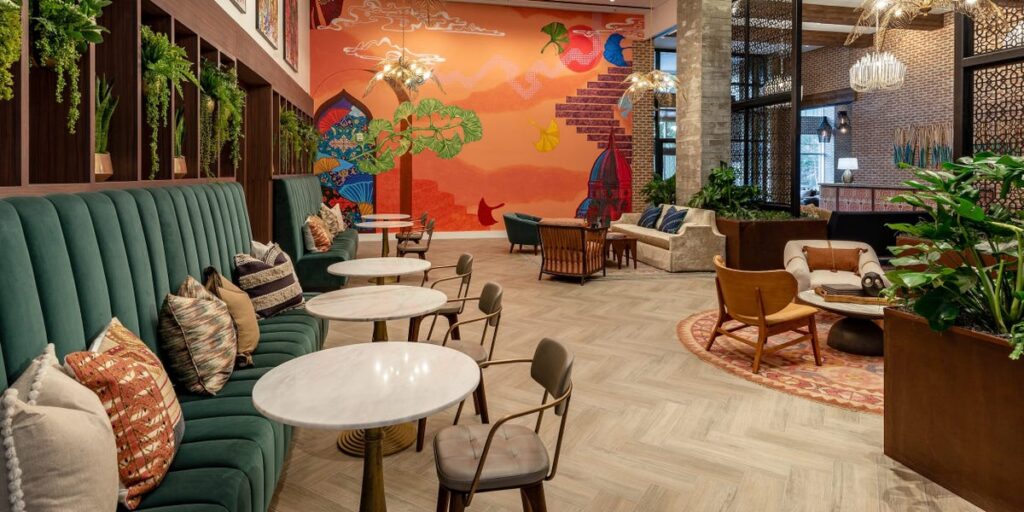Jett Jasper, 37, never wanted to live by himself. So when he moved from Kauai, Hawaii, to Washington, DC, for a job in political communications, he knew he’d need to find roommates.
“I’m a people person. I like to talk to people,” Jasper told Business Insider. “I’m a communicator, so having roommates, I feel, is always a plus versus a negative.”
But moving across the country without knowing anybody is a big undertaking, and he didn’t want to go through the inconvenience of finding and screening roommates himself.
He found the solution in co-living, an arrangement where strangers rent individual rooms but share common areas. It’s not much different than having roommates, except co-living often comes with a built-in community and more amenities, like cleaning services and fully furnished rooms. Plus, developments often vet roommates for you.
Jasper settled on Colette, an apartment development that offers co-living options in addition to traditional units. For $1,400 a month, Jasper gets a fully furnished room in a five-bedroom apartment with access to the same building amenities as other residents, plus included cable and WiFi and cleaning every other week. Colette took care of vetting his one roommate and will vet all future roommates before they move into the remaining unoccupied bedrooms.
For Jasper, the price was right, and the convenience couldn’t be beat.
“It takes a lot of headache and stress out of the equation when your leasing company or your building takes charge of doing the vetting, doing the background checks, the financial checks, and sets you up with a quality person that’s gone through the different hoops to be a roommate,” Jasper said. “It’s definitely a lot easier than getting your own place and maybe putting an ad on Craigslist and hoping for the best.”
Jasper said he and his roommate are getting along great in their first two months living together, and he’s happy with his co-living setup. Not to mention, he’s paying well below D.C.’s $2,155 a month median rent.
Co-living is getting a glow-up
Co-living setups like Jasper’s have been rising in popularity since the mid-2010s, when startups in the space began wooing millennials and Gen Z in expensive cities with the promise of cheaper rent, with the added bonus of community. The arrangement has been endorsed by digital nomads and young professionals alike as a hyper-social option for affordable housing, often earning a reputation for being “adult dorms.”
But co-living has the potential to be more than a fun extension of post-dormitory life; it’s a great tool for reducing the cost of housing without skimping on the frills. According to the US Census, nearly half of renters in 2023 were rent-burdened, meaning they spent more than 30% of their income on housing.
For cities with low housing inventory and increasing office vacancy rates, one specific co-living model could solve both problems at once.
Terry Hogan, a market and data analyst at the global architecture and design firm Gensler, in partnership with The Pew Charitable Trusts, studied the potential of a specific co-living model that could both address housing affordability and revitalize central business districts: Converting office buildings into co-living spaces.
The rise of remote and hybrid work amid the COVID-19 pandemic led many companies to downsize or move out of their office spaces entirely. Now, office-to-residential conversions are on the rise to use the space: According to RentCafe, nearly 71,000 apartment units are being developed from office space in 2025, a 28% increase in units from the previous year and a 206% increase from 2022.
In Gensler’s model, elements of the original structure of an office floor are preserved as a cost-saving measure. Each renter has a private living space, while amenities like kitchens, bathrooms, and living spaces are centralized for the entire floor, similar to how they are in a dorm. The study found that the arrangement, which avoids the expensive task of rerouting the former office building’s plumbing and mechanical systems to each individual unit, could reduce construction costs by 25% to 35% on cost per square footage compared to conventional office-to-residential conversions.
“You would essentially create an affordable alternative to what’s currently on the market that would be in the income range for a much larger slice of the population,” Hogan told Business Insider.
Gensler and The Pew Charitable Trusts conducted studies in cities with high downtown vacancies, a high need for housing, and high median rents, like Albuquerque, Chicago, Denver, Houston, Los Angeles, Minneapolis, Seattle, and Washington, DC. The report found significant price differentials in rent: For example, an office-to-residential co-living double unit in Chicago could rent for as low as $750 a month — far lower than the $1,663 a month median rent for Chicago in January.
Creating affordable housing in major cities while also filling vacant office space is an exciting prospect, but Gensler’s model is just a concept for now. So far, most co-living buildings — Colette included — are ground-up projects.
But the idea that residents could be drawn to the benefits of co-living without even knowing that these models have the potential to transform rental markets is a promising indicator for Hogan.
“Co-living is evolving and becoming quite attractive in a lot of markets across the country right now,” Hogan said. “And that is, I think, reflective of the needs of renters.”
Read the full article here
















